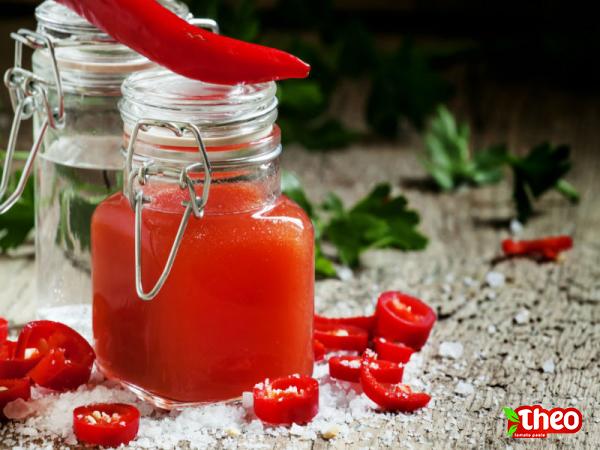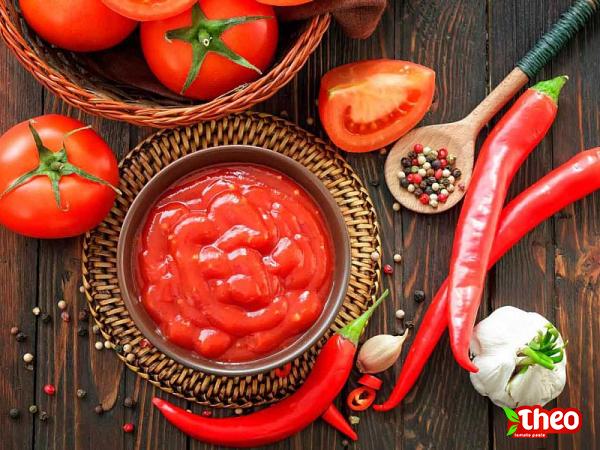Choosing the Perfect Base for Your Recipe Introduction: Chili is a popular and versatile dish enjoyed by many across the globe. With its rich, savory flavors and hearty textures, chili serves as a go-to comfort food for both individuals and large gatherings. One of the key ingredients that gives chili its distinctive taste is tomatoes. When deciding whether to use tomato paste or tomato sauce in chili, understanding the differences, advantages, and specific uses of each is crucial. In this article, we will explore the contrasting features of tomato paste and tomato sauce, helping you make an informed decision for your chili recipe. 1. Understanding Tomato Paste: Tomato paste is a concentrated form of tomatoes that has been cooked down to reduce moisture content. It is made by simmering tomatoes for an extended period, after which the resulting sauce is strained to remove seeds and skins. The remaining thick and concentrated tomato pulp is processed into paste form, resulting in a rich, flavorful ingredient. Advantages of Using Tomato Paste: a) Intense Flavor: Tomato paste has a concentrated flavor that adds depth and richness to chili. Its tangy and slightly sweet notes create a robust taste profile. b) Concentrated Consistency: Tomato paste has a thicker consistency compared to sauce, allowing you to control the texture of your chili. It provides a hearty base and contributes to the overall thickness and body of the dish. c) Enhanced Color: The deep-red color of tomato paste imparts a vibrant hue to chili, making it visually appealing to serve. Specific Uses in Chili: In chili recipes, tomato paste is typically used to create a strong tomato flavor and to thicken the dish. Due to its concentrated nature, tomato paste is ideal for recipes that require a deeper tomato taste or when you desire a thicker chili consistency.

tomato paste
 2. Tomato Sauce and Its Characteristics: Tomato sauce, on the other hand, is a more liquid and less concentrated version of tomatoes, containing added ingredients such as herbs, spices, and occasionally, sugar. It is commonly used as a base for various dishes, including chili. Advantages of Using Tomato Sauce: a) Versatility: Tomato sauce provides a more versatile option as it can be used as a base for different recipes beyond chili, such as pasta sauces, stews, and soups. b) Milder Flavor: Tomato sauce possesses a lighter and less intense flavor compared to tomato paste. Its balanced taste allows other ingredients in the chili to shine while still providing the essence of tomatoes. c) Ready Availability: Tomato sauce is readily available in most grocery stores, making it easier to find and incorporate into your chili recipe. Specific Uses in Chili: Tomato sauce is commonly used in chili recipes that aim for a more balanced and subtle tomato taste. Its liquid nature allows it to distribute evenly among other ingredients and provides a conducive medium for flavors to develop during the cooking process. 3. Balancing the Use of Tomato Paste and Tomato Sauce: To achieve the desired flavor and consistency in your chili, combining both tomato paste and tomato sauce can offer a well-rounded base. This allows you to leverage the strengths of each ingredient and create a more complex and harmonious flavor profile. Best Practices for Using Tomato Paste and Tomato Sauce in Chili: a) Start with Tomato Paste: Begin by sautéing tomato paste with spices and other ingredients to enhance its flavor, creating a rich base before adding liquids. This process maximizes the intensity of the tomato taste. b) Incorporate Tomato Sauce: To balance the tomato flavor and achieve the desired consistency, add tomato sauce to the chili. This will help distribute the flavors throughout the dish without overwhelming the other ingredients. c) Adjust to Personal Preference: Gradually add tomato paste or sauce, tasting as you go, until you attain the desired flavor and thickness. Chili recipes can vary, and personal preferences regarding tomato intensity can differ greatly.
2. Tomato Sauce and Its Characteristics: Tomato sauce, on the other hand, is a more liquid and less concentrated version of tomatoes, containing added ingredients such as herbs, spices, and occasionally, sugar. It is commonly used as a base for various dishes, including chili. Advantages of Using Tomato Sauce: a) Versatility: Tomato sauce provides a more versatile option as it can be used as a base for different recipes beyond chili, such as pasta sauces, stews, and soups. b) Milder Flavor: Tomato sauce possesses a lighter and less intense flavor compared to tomato paste. Its balanced taste allows other ingredients in the chili to shine while still providing the essence of tomatoes. c) Ready Availability: Tomato sauce is readily available in most grocery stores, making it easier to find and incorporate into your chili recipe. Specific Uses in Chili: Tomato sauce is commonly used in chili recipes that aim for a more balanced and subtle tomato taste. Its liquid nature allows it to distribute evenly among other ingredients and provides a conducive medium for flavors to develop during the cooking process. 3. Balancing the Use of Tomato Paste and Tomato Sauce: To achieve the desired flavor and consistency in your chili, combining both tomato paste and tomato sauce can offer a well-rounded base. This allows you to leverage the strengths of each ingredient and create a more complex and harmonious flavor profile. Best Practices for Using Tomato Paste and Tomato Sauce in Chili: a) Start with Tomato Paste: Begin by sautéing tomato paste with spices and other ingredients to enhance its flavor, creating a rich base before adding liquids. This process maximizes the intensity of the tomato taste. b) Incorporate Tomato Sauce: To balance the tomato flavor and achieve the desired consistency, add tomato sauce to the chili. This will help distribute the flavors throughout the dish without overwhelming the other ingredients. c) Adjust to Personal Preference: Gradually add tomato paste or sauce, tasting as you go, until you attain the desired flavor and thickness. Chili recipes can vary, and personal preferences regarding tomato intensity can differ greatly.
Specifications of tomato paste
 Conclusion: When choosing between tomato paste and tomato sauce in chili recipes, understanding their differences and attributes is essential for achieving the desired flavor, texture, and overall appeal of the dish. Tomato paste provides a concentrated tomato flavor and contributes to a thicker consistency, while tomato sauce offers versatility and milder taste. A combination of both can help achieve the perfect balance. Ultimately, personal preference plays a significant role in determining which ingredient, or combination, suits your chili recipe best. Experimentation with varying proportions may lead to the creation of a chili dish that perfectly suits your taste buds.Choosing the Perfect Base: Tomato Paste vs Tomato Sauce in Chili When it comes to making chili, selecting the right base is crucial to achieving the desired flavor and consistency. Tomato paste and tomato sauce are two popular options, each offering distinct characteristics that can significantly impact the overall taste and texture of your chili. In this section, we will delve deeper into the topic, exploring the pros and cons of each base and providing a comprehensive guide to help you make an informed decision for your chili recipe. 1. Tomato Paste: Intense Flavor and Thickness Tomato paste, as mentioned earlier, is a highly concentrated form of tomatoes. Its rich and robust flavor makes it an excellent choice for those who prefer a more intense tomato taste in their chili. The process of simmering tomatoes for an extended period allows the flavors to deepen, resulting in a bold and tangy profile that adds depth and complexity to the dish. Furthermore, tomato paste is known for its thick consistency, which helps create a hearty and substantial chili. By using tomato paste, you can control the thickness of your dish, ensuring it is substantial and satisfying. The concentrated nature of tomato paste also allows it to stand up to other bold flavors and spices that are commonly used in chili recipes. 2. Tomato Sauce: Versatile and Balanced Tomato sauce, on the other hand, provides a more versatile option for making chili. This lighter and less concentrated form of tomatoes can be used as a base for various dishes, including chili. Tomato sauce typically contains added ingredients like herbs, spices, and occasionally sugar, which can enhance the overall flavor profile of your chili. The milder flavor of tomato sauce allows for greater flexibility in creating a chili dish that is balanced and harmonious. It complements other ingredients without overpowering them, allowing their individual flavors to shine through. Additionally, the liquid nature of tomato sauce helps distribute the flavors evenly throughout the chili, allowing the ingredients to meld together during the cooking process.
Conclusion: When choosing between tomato paste and tomato sauce in chili recipes, understanding their differences and attributes is essential for achieving the desired flavor, texture, and overall appeal of the dish. Tomato paste provides a concentrated tomato flavor and contributes to a thicker consistency, while tomato sauce offers versatility and milder taste. A combination of both can help achieve the perfect balance. Ultimately, personal preference plays a significant role in determining which ingredient, or combination, suits your chili recipe best. Experimentation with varying proportions may lead to the creation of a chili dish that perfectly suits your taste buds.Choosing the Perfect Base: Tomato Paste vs Tomato Sauce in Chili When it comes to making chili, selecting the right base is crucial to achieving the desired flavor and consistency. Tomato paste and tomato sauce are two popular options, each offering distinct characteristics that can significantly impact the overall taste and texture of your chili. In this section, we will delve deeper into the topic, exploring the pros and cons of each base and providing a comprehensive guide to help you make an informed decision for your chili recipe. 1. Tomato Paste: Intense Flavor and Thickness Tomato paste, as mentioned earlier, is a highly concentrated form of tomatoes. Its rich and robust flavor makes it an excellent choice for those who prefer a more intense tomato taste in their chili. The process of simmering tomatoes for an extended period allows the flavors to deepen, resulting in a bold and tangy profile that adds depth and complexity to the dish. Furthermore, tomato paste is known for its thick consistency, which helps create a hearty and substantial chili. By using tomato paste, you can control the thickness of your dish, ensuring it is substantial and satisfying. The concentrated nature of tomato paste also allows it to stand up to other bold flavors and spices that are commonly used in chili recipes. 2. Tomato Sauce: Versatile and Balanced Tomato sauce, on the other hand, provides a more versatile option for making chili. This lighter and less concentrated form of tomatoes can be used as a base for various dishes, including chili. Tomato sauce typically contains added ingredients like herbs, spices, and occasionally sugar, which can enhance the overall flavor profile of your chili. The milder flavor of tomato sauce allows for greater flexibility in creating a chili dish that is balanced and harmonious. It complements other ingredients without overpowering them, allowing their individual flavors to shine through. Additionally, the liquid nature of tomato sauce helps distribute the flavors evenly throughout the chili, allowing the ingredients to meld together during the cooking process.
buy tomato paste
 3. Combining Tomato Paste and Tomato Sauce: Best of Both Worlds To create a chili with a more complex and well-rounded flavor, many chefs and home cooks often combine tomato paste and tomato sauce. This combination maximizes the advantages of both bases, resulting in a chili that is flavorful, thick, and balanced. By starting with tomato paste, you can sauté it with spices and other ingredients to intensify the tomato flavor and create a rich base. Then, by adding tomato sauce, you can achieve the desired consistency and distribute the flavors more evenly throughout the dish. Balancing the proportions of tomato paste and tomato sauce allows for customization, ensuring the chili suits your personal preferences and culinary goals. 4. Best Practices for Using Tomato Paste and Tomato Sauce in Chili To help you navigate the process of using tomato paste and tomato sauce in chili, here are some best practices to consider: a) Start with Tomato Paste: Begin by sautéing tomato paste with spices, herbs, and aromatics to enhance its flavor. This process allows the tomato paste to develop its full potential, contributing to the overall depth of the chili. b) Add Tomato Sauce Gradually: Once the tomato paste has been sautéed and mixed with other ingredients, begin adding tomato sauce gradually. This will help you achieve the desired consistency and balance the tomato flavor with the other components of the chili. c) Adjust to Personal Preference: Taste and adjust as you go along, adding more tomato paste or tomato sauce depending on your personal preference. Everyone’s taste buds are unique, so it’s essential to find the right balance that suits your palate. d) Experiment with Ratios: Feel free to experiment with different ratios of tomato paste and tomato sauce to find the perfect combination. Some prefer a stronger tomato flavor, while others may seek a milder taste profile. e) Consider Recipe Requirements: Pay attention to individual chili recipes as well. Some recipes may call specifically for tomato paste or tomato sauce in fixed quantities. Adapting the base accordingly ensures that you stay true to the recipe’s intended flavors. 5. Other Factors to Consider Apart from tomato paste and tomato sauce, there are a few other factors to consider when deciding on the base for your chili. These include: a) Time Constraints: Tomato paste requires more time to develop its flavors, as it needs to be sautéed before adding other ingredients. If you’re short on time, tomato sauce may be a more convenient option. b) Personal Preferences: Determine the intensity of tomato flavor you desire in your chili. If you prefer a bolder and more pronounced tomato taste, tomato paste may be the way to go. If a milder flavor is preferred, tomato sauce would be a better choice. c) Availability and Cost: Both tomato paste and tomato sauce are widely available in most grocery stores. Consider cost and availability when making your decision, especially if you’re planning to cook large batches of chili. d) Dietary Restrictions: Take into account any dietary restrictions or preferences, such as low-sodium or sugar-free options. Some tomato sauce varieties cater to specific dietary needs, providing alternatives for those with dietary restrictions. e) Storage and Shelf Life: Consider the shelf life and storage requirements of both tomato paste and tomato sauce. Tomato paste typically comes in small cans or tubes, making it easier to store and use in smaller quantities. Tomato sauce, on the other hand, usually comes in larger cans or jars and may require refrigeration once opened. 6. Summary and Conclusion In conclusion, when choosing between tomato paste and tomato sauce for your chili recipe, it is essential to consider the flavor intensity, desired consistency, and overall culinary goals. Tomato paste offers an intense flavor and contributes to a thicker chili, while tomato sauce provides versatility and a milder taste profile. Combining both bases can result in a chili that embraces the best of both worlds. Ultimately, the choice between tomato paste and tomato sauce depends on personal preferences, recipe requirements, and the desired outcome. Experimenting with different ratios and adjusting the ingredients according to your taste will help you create a chili that perfectly suits your palate. With careful consideration and an understanding of the unique qualities of each base, you can elevate the flavor of your chili and turn it into a standout dish that will impress family and friends.
3. Combining Tomato Paste and Tomato Sauce: Best of Both Worlds To create a chili with a more complex and well-rounded flavor, many chefs and home cooks often combine tomato paste and tomato sauce. This combination maximizes the advantages of both bases, resulting in a chili that is flavorful, thick, and balanced. By starting with tomato paste, you can sauté it with spices and other ingredients to intensify the tomato flavor and create a rich base. Then, by adding tomato sauce, you can achieve the desired consistency and distribute the flavors more evenly throughout the dish. Balancing the proportions of tomato paste and tomato sauce allows for customization, ensuring the chili suits your personal preferences and culinary goals. 4. Best Practices for Using Tomato Paste and Tomato Sauce in Chili To help you navigate the process of using tomato paste and tomato sauce in chili, here are some best practices to consider: a) Start with Tomato Paste: Begin by sautéing tomato paste with spices, herbs, and aromatics to enhance its flavor. This process allows the tomato paste to develop its full potential, contributing to the overall depth of the chili. b) Add Tomato Sauce Gradually: Once the tomato paste has been sautéed and mixed with other ingredients, begin adding tomato sauce gradually. This will help you achieve the desired consistency and balance the tomato flavor with the other components of the chili. c) Adjust to Personal Preference: Taste and adjust as you go along, adding more tomato paste or tomato sauce depending on your personal preference. Everyone’s taste buds are unique, so it’s essential to find the right balance that suits your palate. d) Experiment with Ratios: Feel free to experiment with different ratios of tomato paste and tomato sauce to find the perfect combination. Some prefer a stronger tomato flavor, while others may seek a milder taste profile. e) Consider Recipe Requirements: Pay attention to individual chili recipes as well. Some recipes may call specifically for tomato paste or tomato sauce in fixed quantities. Adapting the base accordingly ensures that you stay true to the recipe’s intended flavors. 5. Other Factors to Consider Apart from tomato paste and tomato sauce, there are a few other factors to consider when deciding on the base for your chili. These include: a) Time Constraints: Tomato paste requires more time to develop its flavors, as it needs to be sautéed before adding other ingredients. If you’re short on time, tomato sauce may be a more convenient option. b) Personal Preferences: Determine the intensity of tomato flavor you desire in your chili. If you prefer a bolder and more pronounced tomato taste, tomato paste may be the way to go. If a milder flavor is preferred, tomato sauce would be a better choice. c) Availability and Cost: Both tomato paste and tomato sauce are widely available in most grocery stores. Consider cost and availability when making your decision, especially if you’re planning to cook large batches of chili. d) Dietary Restrictions: Take into account any dietary restrictions or preferences, such as low-sodium or sugar-free options. Some tomato sauce varieties cater to specific dietary needs, providing alternatives for those with dietary restrictions. e) Storage and Shelf Life: Consider the shelf life and storage requirements of both tomato paste and tomato sauce. Tomato paste typically comes in small cans or tubes, making it easier to store and use in smaller quantities. Tomato sauce, on the other hand, usually comes in larger cans or jars and may require refrigeration once opened. 6. Summary and Conclusion In conclusion, when choosing between tomato paste and tomato sauce for your chili recipe, it is essential to consider the flavor intensity, desired consistency, and overall culinary goals. Tomato paste offers an intense flavor and contributes to a thicker chili, while tomato sauce provides versatility and a milder taste profile. Combining both bases can result in a chili that embraces the best of both worlds. Ultimately, the choice between tomato paste and tomato sauce depends on personal preferences, recipe requirements, and the desired outcome. Experimenting with different ratios and adjusting the ingredients according to your taste will help you create a chili that perfectly suits your palate. With careful consideration and an understanding of the unique qualities of each base, you can elevate the flavor of your chili and turn it into a standout dish that will impress family and friends.




